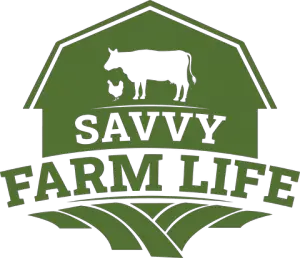List of Small Goat Breeds
There are several reasons that goats have become popular pets – they are friendly, curious, and adorable. While I have yet to meet a goat face that didn’t make me smile (or laugh!), most miniature goat breeds tend to melt the most hearts. Whether you are looking for a milking goat, an adorable lawnmower, or strictly a pet, you will find the breed for your family in this list of cute pixie-sized goat breeds.
Which goat breeds are the smallest (and cutest)? There are several small goat breeds, all stemming either from the Pygmy or the Nigerian Dwarf in their ancestry tree. Eight of the most adorable small goat breeds include the:
- Pygmy
- Nigerian Dwarf
- Kinder
- Mini Nubian
- Pygora
- Nigora
- Mini Alpine
- Mini Silky (Mini Fainting Goat)
Miniature goats are not for everyone, and they do not meet the needs of every goat operation. But for many farmers and homesteaders, small goats offer almost as much productivity as their larger counterparts in a much more reasonably-sized animal. Read on to learn more about each of these breeds and the advantages and disadvantages of raising them.
The “Original” Small Goat Breeds
The Pygmy and the Nigerian Dwarf are popular goat breeds originating from West Africa. They offer benefits such as meat and dairy in a small, easy-to-manage package. The two “original” small goat breeds are the Pygmy and the Nigerian Dwarf.
#1 Adorable Small Goat Breed: Pygmy
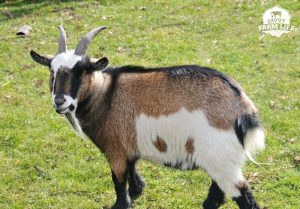
Pygmy goats are native to West Africa and are also known as Cameroon Dwarf goats. They reach an average height of 15-20 inches at the withers, making them the smallest goat breed available. Males average 40-60 pounds at maturity, while females are slightly smaller when fully grown, averaging 35 to 50 pounds.
Pygmy goats are small and stocky, and while they are popular in the United States as pets and backyard milk goats, they are used primarily in their native region for their meat. They are hardy in almost any climate and are particularly resistant to parasites (like the barber pole worm).
Like many goat breeds, especially the smaller ones, they are friendly, playful, and gentle enough for the children to raise. Pygmy goats come in various colors and coat patterns and have a full coat of medium-long hair, depending on the season. While the females have sparse beards, bucks tend to sport full, long beards.
Are you interested in buying Pygmy goats? Visit my article How Much Do Pygmy Goats Cost? Buying Guide.
#2 Adorable Small Goat Breed: Nigerian Dwarf
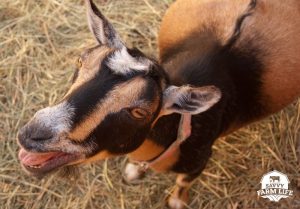
Another goat originating from West Africa, the Nigerian Dwarf, is one of the most popular (pet) goat breeds to raise in the United States. They can be found almost anywhere and make wonderful pets. Nigerian Dwarfs top out at 17-21″ in height, making them slightly larger than the Pygmy goats. Both males and females reach an average weight of 75 pounds.
Nigerian Dwarf goats make wonderful pets – for their size, but they are pretty productive as dairy goats. The USDA classifies them as a dairy goat breed, making them popular among 4H and FFA youth. Nigerian Dwarf goats produce approximately ½ gallon of sweet, creamy goat milk per day, with a very high butterfat content of 6-10% (compared to an average 4% butterfat among dairy goat breeds). Higher butterfat gives the Nigerian Dwarf’s milk a sweeter and less “goaty” taste and allows more cheese and butter to be produced per gallon of milk.
Nigerian Dwarf goats are friendly, lovable, and gentle. They make engaging pets, with even breeding bucks proving to be manageable for beginners. So many Nigerian Dwarfs in the US are explicitly bred as pets that one must inquire about the goat’s parentage if interested in a milk-productive goat.
Small Goat Crossbreeds
Many “mini” goat breeds were produced by crossing a full-sized goat breed with the Pygmy or the Nigerian Dwarf. Many of these crossbreeds are “first-generation” and relatively new to the market.
#3 Adorable Small Goat Breed: Kinder
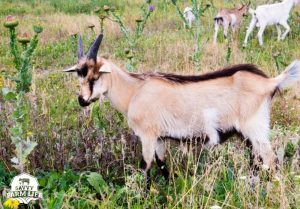
If you are looking for a reasonably-sized goat to keep for meat or milk (or both), the Kinder might be a good choice. Kinder goats are larger than the Pygmy and Nigerian Dwarf but on the small size compared to other full-sized productive breeds. Kinders were developed by crossing the Pygmy with the Nubian goat. Kinder goats mature to 115-135 pounds when full-grown and only 23-25″ tall at the withers.
Kinders are a true dual-purpose breed, used productively as both a dairy goat and a meat goat. Because of the Kinder’s stocky build and fast growth rate make a profitable meat goat and grow a rapid .3-.4 pounds per day. Kinders also excel as dairy goats, producing up to 1 gallon of over 6% butterfat-rich milk per day.
Kinders are easy to manage and known to be quiet, gentle, and polite. The disposition of the Kinder makes it another popular 4H and FFA goat among youth.
#4 Adorable Small Goat Breed: Mini Nubian
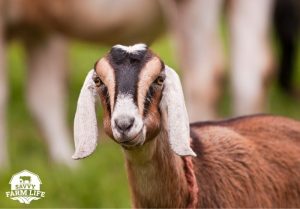
Mini Nubians were developed by crossing the productive Nubian dairy breed with the smaller Nigerian Dwarf. Mini Nubians reach a mature height of 23-31″ and an adult weight of around 100 pounds. Though slightly larger than the typical Nigerian Dwarf, Mini Nubians produce almost as much milk as their full-grown Nubian parent. On much less feed, they are a feed-efficient dairy goat, with a size that makes them perfect for smaller homesteads.
#5 Adorable Small Goat Breed: Pygora
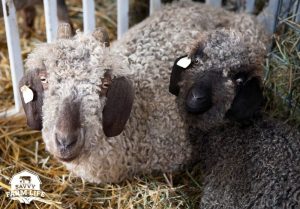
The Pygora was developed by crossing the Pygmy goat with the Angora – a goat famous for its long, silky fiber coat. Pygoras reach a mature weight of 65-95 pounds and 18-23″ in height. Pygoras may have long, lustrous fiber, soft cashmere, or a blended fleece, depending on their parentage. Those with long Angora fiber must be shorn (usually twice yearly), while the other two coat types shed annually without assistance.
While Pygoras can be used for their milk, they are most often used as pets or for their fiber. They are gentle goats with calm dispositions and are excellent with children.
#6 Adorable Small Goat Breed: Nigora
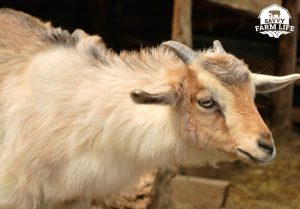
Nigoras are similar to Pygoras in that they were both developed using the Angora goat. The only difference is that Nigoras share the Nigerian Dwarf as an ancestor instead of the Pygmy goat. They reach between 19 and 29 inches tall and are slightly heavier on average than the Pygora.
Nigoras offer the best of both (actually, many) worlds – they have the beautiful fleece of the Angora, the friendly nature and diminutive size of a pet goat, and they provide an abundance of butterfat-rich milk thanks to their Nigerian Dwarf parentage.
#7 Adorable Small Goat Breed: Mini Alpine
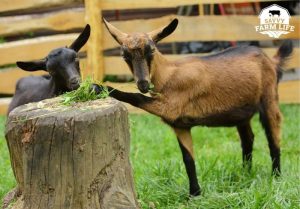
Alpine goats are one of the top milk-producing goats around. If you cross the Alpine with the productive and smaller Nigerian Dwarf, you get the Mini Alpine. Mini Alpines produce an abundance of milk at a more manageable size. They reach a mature height of 28-29″, making them similar in size to the Mini-Nubian.
Mini Alpines are a newer breed and are currently bred by crossing a purebred Alpine with a purebred Nigerian Dwarf (in other words, first-generation). When crossing a full-sized breed with a smaller breed in this manner, the buck must always be of the smaller breed. Crossing a full-sized buck with a smaller doe can result in tragic birthing problems.
If you do plan on breeding your own goats, you’ll need to be able to recognize when your female goats are in heat and ready to breed. To get a complete rundown, visit my article Signs of Heat in Goats: 6 Signs a Goat is in Heat.
#8 Adorable Small Goat Breed: Mini Silky
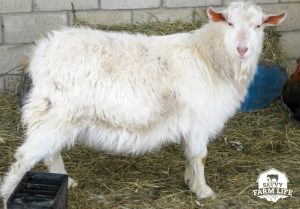
Mini Silkies were developed by crossing the long-haired Myotonic (or Tennessee Fainting Goat) with the Nigerian Dwarf. The result is a small goat with long, silky hair that faints when startled. Mini Silkies reach 22-26″ in height and only about 50-80 pounds at maturity. They have long, luxurious coats and are friendly and sweet-natured. Myotonics are often used for meat, so while the Mini Silky can theoretically be used as a meat goat, it is most often kept as a fun pet.
Because of the genetics of the Myotonic, Mini Silkies will “faint” when afraid or surprised. This gene causes the goat’s muscles to lock into place when startled, lasting 10-15 seconds. Because the muscles lock, the goats fall over, unable to move. This is a harmless condition and can benefit the handler as it makes the goats easier to catch. That being said, you never want to do anything that will cause excessive stress in your animal’s life.
Productive Goats May Come In Small Packages
You may prefer a smaller goat breed because you have children involved in the homestead chores, or you may choose a smaller breed because you have limited space. Whatever your reason for looking at mini goats, it should be encouraging to know that you needn’t sacrifice productivity for the smaller size. Goats crossed with Nigerian Dwarfs rival the production of many larger dairy breeds, and goats crossed with the Pygmy can offer a sustainable source of meat in a manageable size. Regardless of the purpose of adding goats to your homestead, none of the breeds listed here will disappoint.
Regardless of their size, goats are notorious escape artists. They are excellent at climbing and jumping. To learn some ways you can keep your goats from climbing out of their pen, visit my article How Goats Can Climb Almost Anything (Pictures Included.)
